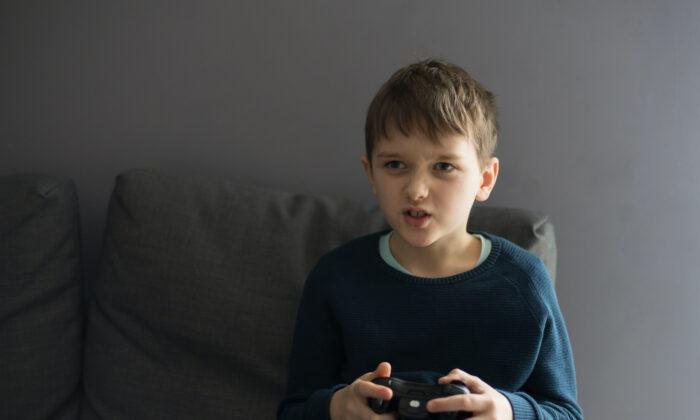Mindfulness may be growing in popularity, but so is the opposite trend – digital distraction. And stress caused by digital distraction is hurting our kids.
Why Screen Media is Not Relaxing
What we think is relaxing is not.When my oldest son began gaming three to five hours a day, I knew he was wasting time. What I didn’t know was that while he was climbing the leaderboard in his game, his stress hormones were climbing to new levels, too. His adrenal glands were being prompted to release a surge of adrenaline and cortisol-resulting in high blood pressure, an increased heart rate, and a boost of energy to fight, in this case, a virtual enemy.
I had missed all the signs of toxic stress in my son. He was irritable, stayed up all night, had angry outbursts, and was easily depressed. I even noticed stains on his pants from where he had wiped his sweaty hands during the game.
I thought gaming was what he did to relieve stress and I thought he deserved a break from his homework. After all, he was a straight ‘A’ student. Didn’t he need downtime?
Gaming and Social Media Use Wreak Havoc on the Developing Brain
I now know that gaming (as well as social media use) is one of the least relaxing downtime activities. The stress it causes will wreak havoc on the developing brain, leading to issues that last well into adulthood.This is the underlying reason that our new cultural norm of putting video games and smartphones in the laps of every child, has made childhood today the most anxiety-filled stage of development.
Novelty is Addictive
Everything new is fun.The job of every video game and social media platform is to keep users online. The job of every parent is to make sure your child isn’t one of those hooked.
The persuasive design elements used in games and social media platforms — rewards, upgrades, leaderboards, comments, likes, and hearts—are similar to those used to addict gamblers at casinos. This idea is relatively easy to understand. What is harder to recognize are the additional techniques used by designers to keep our kids hooked—novelty and fear.
Fear Keeps a Player Engaged
Gaming is life or death to the revved-up brain.The element of fear is just around the corner in every game, even the E-rated ones. Why? Because game designers know that the fear of dying produces adrenaline, and keeps the player engaged.
If a child is playing a nonviolent game, he may have to jump over a turtle, dodge a fireball, or avoid falling down a hole or lava pit – all before the timer runs out. If he is playing a violent game, like Fortnite, he must fight for his life to stay alive and in the game. Both types of games are thrilling and stressful at the same time.
Parents struggle to understand the ramifications of this fear factor. For an adult, the threat of losing a character in a game is trivial. For a child, it is everything. These virtual deaths are lifelike. When there are threats to a character’s life, the brain’s amygdala sounds an alarm that danger is ahead. This activates a series of survival responses, putting the brain in a state of high alert. Because the brain can’t tell the difference between a real physical threat and a virtual one, the fight-or-flight response system kicks in, releasing a cascade of chemicals. This spike in adrenaline and cortisol triggers physiological changes like rapid breathing, increased pulse, and a release of glucose to prepare the body to react to danger. Focus narrows and a heightened response to immediate stimuli displaces executive function.
Stress in Virtual Life Equals Stress in Real Life and This Stress Hurts Our Kids
Overusing this fight-or-flight system through repeated interactive screenplay results in the stress release pathway becoming faster and stronger. This is how playing video games actually shapes the structure of the brain. Like a tire track in wet cement, over time this stress pathway hardens into a rut that becomes the preferred route when other triggers occur in the real world.Once the stress pathway becomes the path of least resistance, real-life threats access it easily. Your child may overreact with a stress response for a trivial reason because that route has become his default mode when provoked.
Maybe he throws something in anger or says something vicious. Remember his impulse control skills are not yet honed, but his fight-or-flight response is.
Parents usually don’t notice the problem until the stress signs are more pronounced. You may notice relationship conflicts, lying, a lower attention span for academic work, an inability to focus, and more aggressive behaviors in real-life play. Parents may get therapists involved because their child is acting out in school.
Doing anything when you are stressed is difficult. Teens under chronic stress, due to too much game time and not enough sleep, will not reach their academic potential. Screen stress can make it more difficult to plan ahead, solve problems, have empathy, or think through the consequences of actions.
Digital Media Changes A Child’s Relationships
The game becomes his new family.All the time a child invests in the virtual world makes it hard to walk away. Children feel anxious when they try, which causes even more stress.
When children spend time building a sense of belonging in the virtual world, their shallow online relationships and chronic state of stress become normalized. The real world then feels awkward and uncomfortable.
Meanwhile, the opportunity cost has become significant, possibly as great as the toll that this stress is taking on a child’s mind and body.
The chronic stress state keeps your child from discovering healthy interests and hobbies during adolescence. This time in life is critical because the brain and body are going through crucial phases of development. The brain is strengthening well-used pathways and pruning those left unused.
Moderation Doesn’t Work When It Comes To Toxic Screen Use
Moderation works for non-stressful screen activities like family movies or schoolwork. But moderation does not work for toxic, stress-producing interactive screen use.When your child plays a video game or scrolls through a social media account for 30 minutes a day, he is building a strong habit. Even brief daily exposure will stimulate and strengthen the stress pathway. Stress effects are cumulative and ingrained, meaning that your child’s brain doesn’t get a clean slate every morning to start over.
Drop the Screen to Relieve the Stress
There is much debate over best practices for managing stressful screens. Therapists, other parents, and even the neighbor next door, all offer opinions. However, when you consider the brain science of how chronic stress is changing our kids’ brains and making them suffer, the answer is simple: remove the stimulant so the brain can reset and heal.Is this easy?
No. The best solutions are rarely easy or popular. But it works, and many families are finding that their kids are thriving without video games and social media. Playing video games is not a mandatory or a healthy activity for kids, nor is constantly viewing a selection of carefully curated photos and videos of others.
The most successful resets occur when parents boldly eliminate toxic screen use—video games and social media—from their child’s digital diet. Focus on real-life activities that require movement and exposure to nature, natural remedies for stress.
Don’t Be Afraid to be a Countercultural Parent
Countercultural parents understand that relationships are a natural safeguard against the dangers of toxic stress. When children experience free play with others off-line, they are healthier and even smarter. Teens that spend in-person time with friends are more calm and less anxious. When kids spend time with their families, they enjoy a deeper sense of attachment and happiness. There are no guarantees, but when you remove toxic screens, you increase the odds of having happier and healthier kids.Community Calms Us While Isolation Stresses Us Out. Teach your kids how to keep a few good friends and enjoy building in-person relationships. This is the life your kids are craving.
You won’t regret it.






